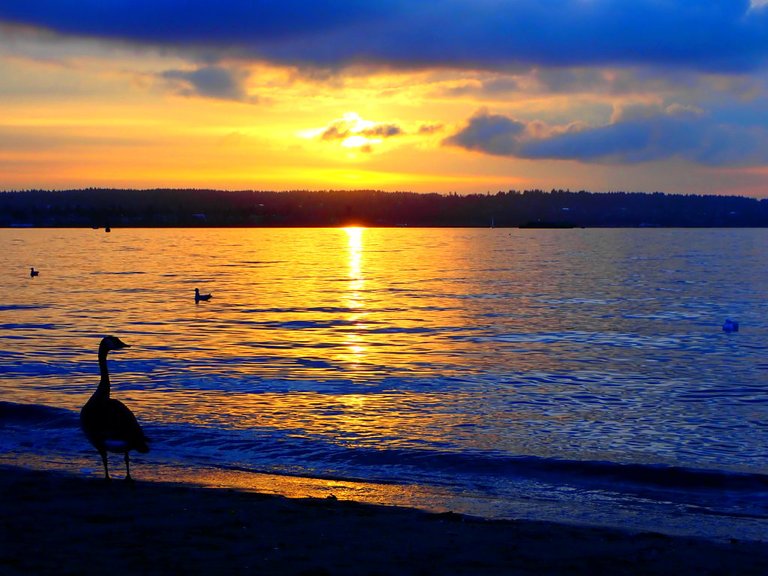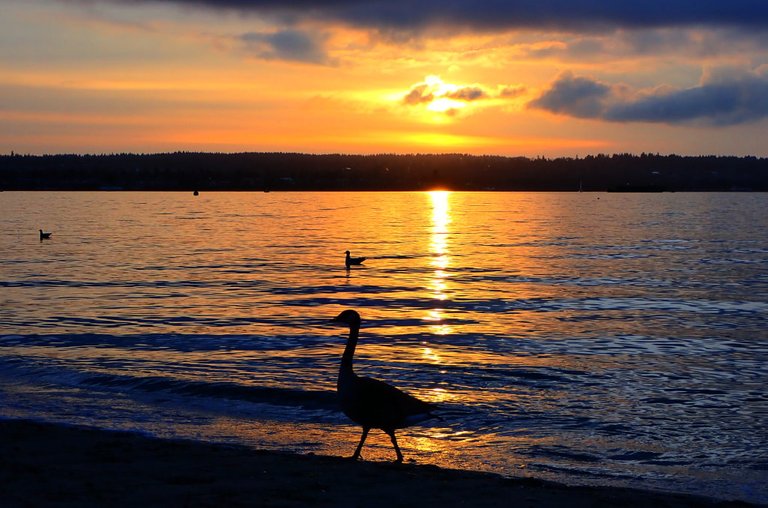Red-Eared Slider, Copley Pond Park, New York, USA
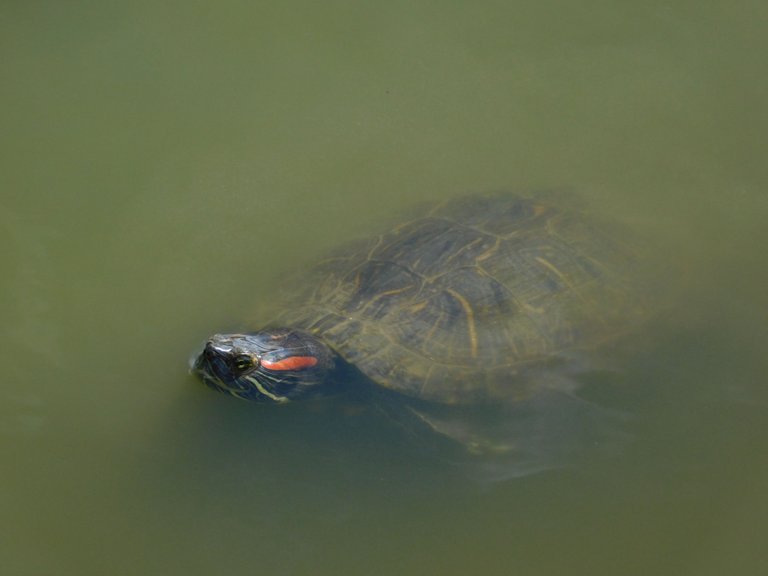
Image credit: agmoore
This photogenic turtle was swimming near the shore in a small neighborhood pond recently. The turtle convivially shared the water with other pond creatures, including Canada geese and Mallard ducks. One thing that struck me as I watched the peaceful scene, was how well these different species tolerated each other. For example, here's a picture of the geese swimming past a turtle. This turtle will become a central character in my blog today.
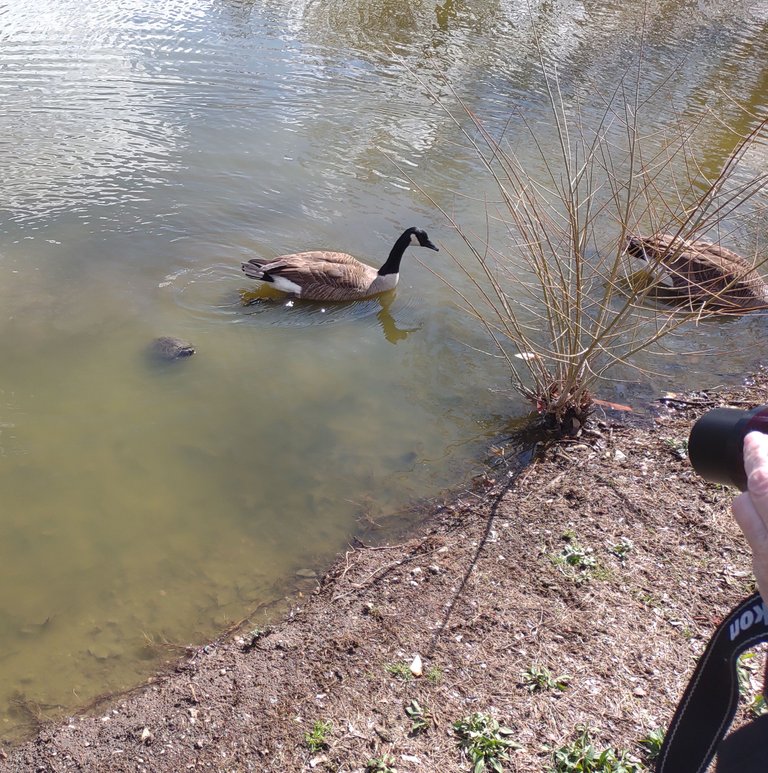
Image credit: My husband snapped this shot with his cell phone. That's my hand and my camera in the frame.
And then there were the ducks. Here is a picture of them contentedly swimming behind a goose.
Ducks at Copley Pond Part, New York
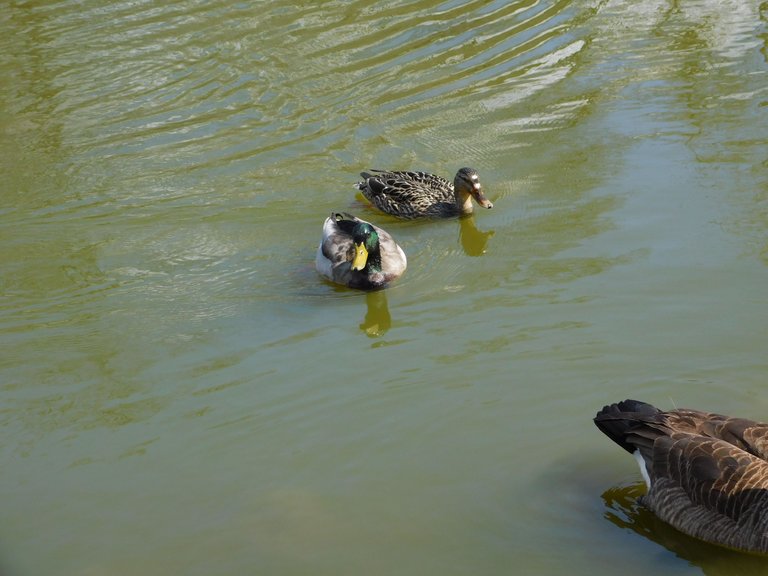
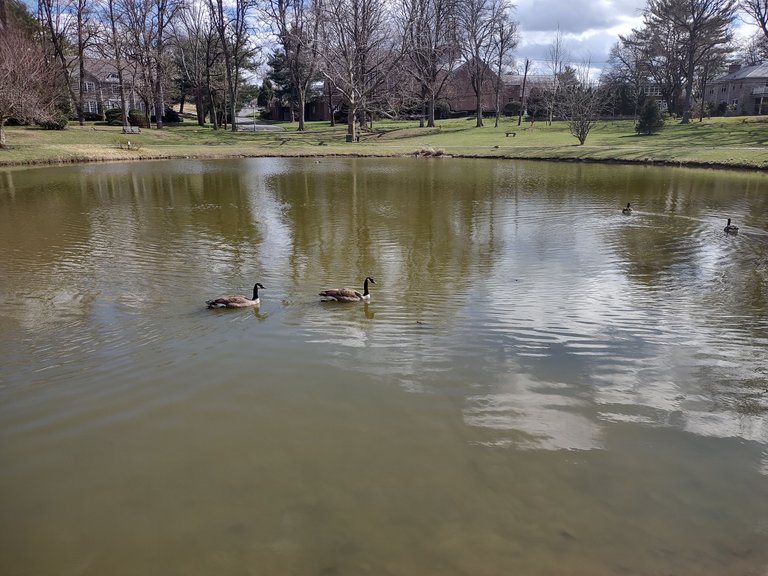
As I watched the three animal species use the resource of the pond harmoniously, I recalled all those nature videos I'd seen of watering holes where prey animals tried to get a sip as predators picked off a few of the most vulnerable in their midst.
I wondered about the pond as an ecosystem. In a way, the pond, the turtles, the geese and the ducks were all characters in the natural drama that was playing out before my eyes. Why do the geese, the turtles and the ducks find the pond a congenial place to hang out?
Each of these characters played a distinct role so I tried to learn about each one and how each animal came to be there for me to enjoy on that afternoon.
It turns out the only one that actually would be there without human intervention (anthropogenic action) was the duck.
Canada Geese (Branta Canadensis) Introduced
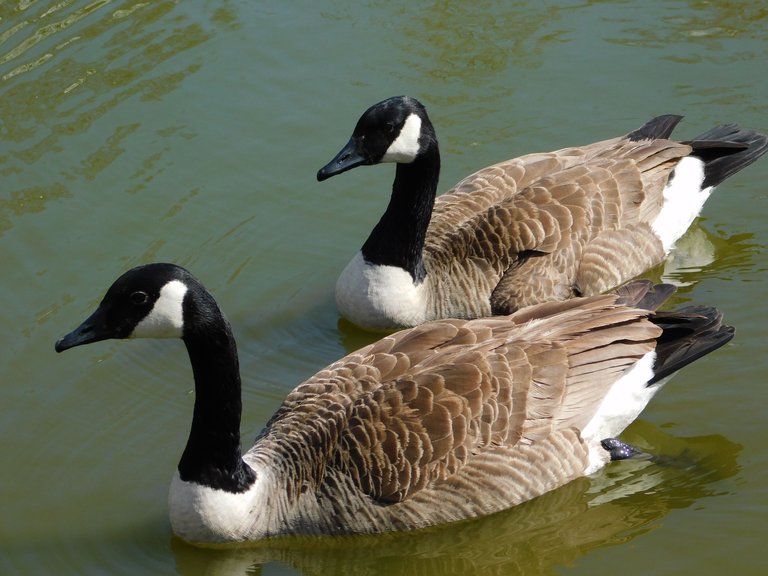
Credit: agmoore
The geese were Canada geese. This species was introduced into New York in the early 1900s. They were originally owned by private individuals who lived near the Hudson River. The geese were released into the wild and proliferated. Today, (although I love to look at them) they are considered an invasive species. However, they are protected by law. There is a goose hunting season that lasts thirty days and limits the number of geese killed to one per day. Beyond that, people are not allowed to injure a goose, although they may harass it.
Today it is estimated that there are about 200,000 resident Canada geese in New York State. Additionally, there are hundreds of thousands of migratory birds that return seasonally. The problem between humans and geese arises because of the bird's preferred nesting environment. They like flat areas abundant in fertilized grass, within reach of water. This preference places them on lawns, golf courses and even grassy mounds in parking lots. While the geese may be beautiful, they produce prodigious amounts of excrement--about two pounds a day. This excrement production is what makes them unwelcome guests in many areas.
The Red-Eared Slider (Trachemys Scripta Elegans)
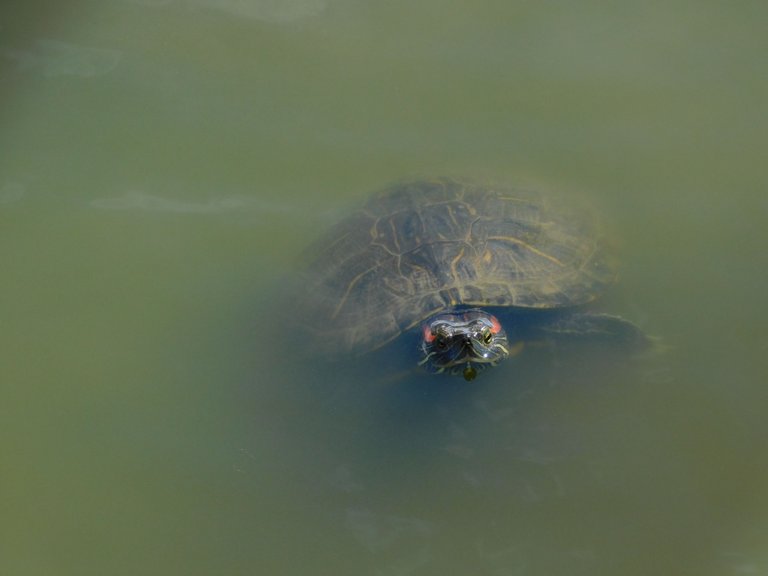
Image credit: agmoore
The turtle in my picture looks a lot like a native species, the painted turtle, but the slider is actually invasive. As is true with the goose, humans released these animals into the wild. First purchased as pets, the red-eared slider became a tiresome addition to many households. They live a long time (20 years in captivity and up to 70 in the wild), are prolific producers of excrement, and spread disease.
The slider is a hardy species and survives in just about any environment. Once released into the wild, they proliferated. They are larger and more aggressive than the native painted turtle. The red-eared slider wins out in a competition for space, and resources (especially food). In the pond I visited, this was the only species I saw. (Technically, red-eared sliders are terrapins, which means they spend time in the water and on land).
All amphibians in New York are covered by law, which means there are regulations about releasing them into the wild (don't!) and regulations that cover injuring them. They may be killed, but only by a vet through humane euthanasia.
The Mallard Duck (Anas Platyrhynchos)
(Picture snapped at a neighboring pond: Female in the front)

Image credit: agmoore
According to the Cornell Lab at Cornell University, the Mallard duck is the “most widespread abundant duck” in North America, and may be found abundantly in many parts of the world. Because the Mallard successfully breeds with other species, most varieties of duck in North America are descended from this species. Although the Mallard might have made its way to the neighborhood pond without human intervention, the species is still affected by human action.
The Mallard is the most popularly hunted duck in North America. It also has become habituated to humans in some areas, especially in locales where humans might offer them food (such as parks).
Copley Pond
(The goose is taking note of the turtle in this picture)
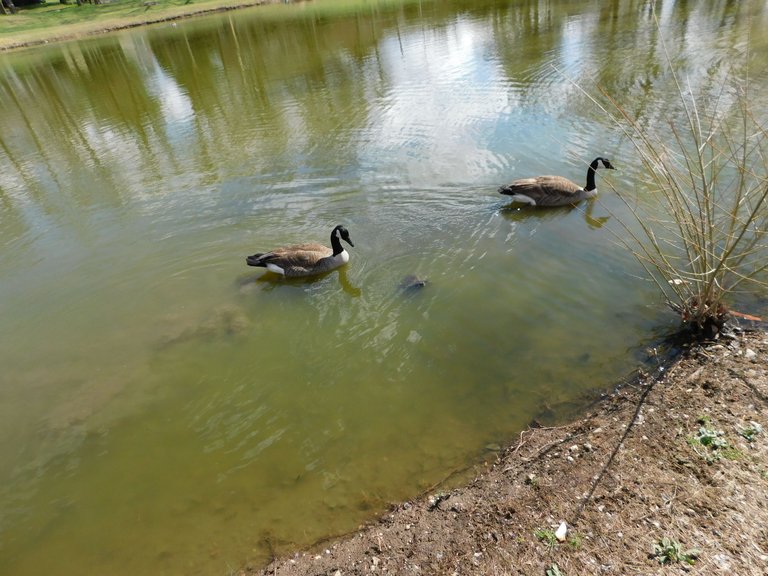
It would be hard to say whether this pond would have existed without human intervention. Long Island is so highly developed that water tables are profoundly affected. The US Geological Survey in 2018 issued a report on the effect of development and water use on streams, ponds and lakes on Long Island. Long Island is an island (although, in 1985 the US Supreme Court defied geography and ruled that legally, it was a peninsula). We have ponds, lakes and streams that pop up all over the island. This is the case with Copley Pond, although the pond is so small I have not been able to find an article that addresses the issue. Ponds that pop up and are fed by an underlying water source are called table ponds. Ponds that exist because of seasonal precipitation are called vernal ponds. It seems pretty certain, given the geography of Long Island, that Copley is a table pond.
As I walked around the pond, there were signs of life everywhere. It's spring, a time of renewal. Renewal, for our three featured animals in this blog, means nesting and breeding. Copley Pond offers not only a congenial place for our animal friends to hang out. It also provides an ideal nesting/breeding area. All three animals reproduce sexually, but maternal care of the young varies significantly. In each case, though, nesting occurs within reach of water.
Canada Geese
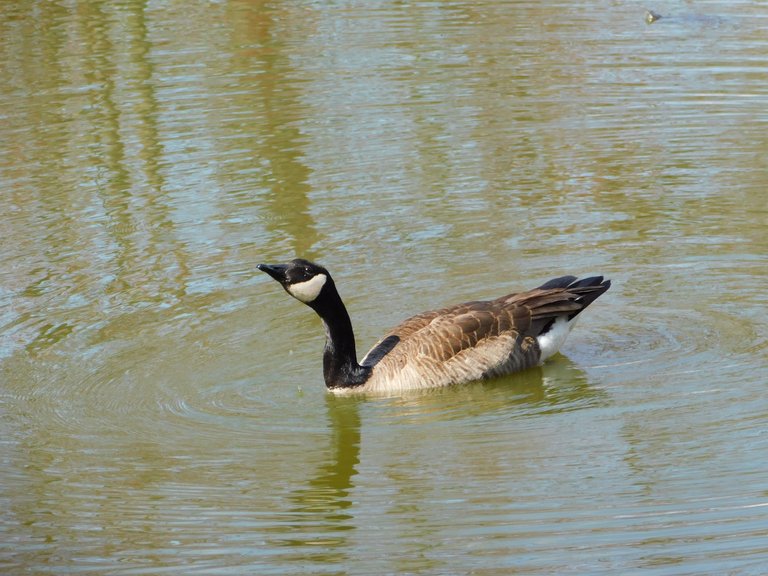
Image credit: agmoore
Canada geese mate for life. It has been reported that if one of the pair dies, the other will mourn. The mourning may go on for a very long time, especially in older geese. Egg laying takes place (on Long Island) perhaps in April. The female builds a nest on high ground, usually within reach of water. She lays eggs once a year, on average. Hatching occurs about a month later.
The Canada goose is a devoted mother. She will not eat or leave her nest during incubation. She lays an average of five eggs a year. The father is aggressively protective of his family, and both parents are ferociously protective of their young.
Red-Eared Slider
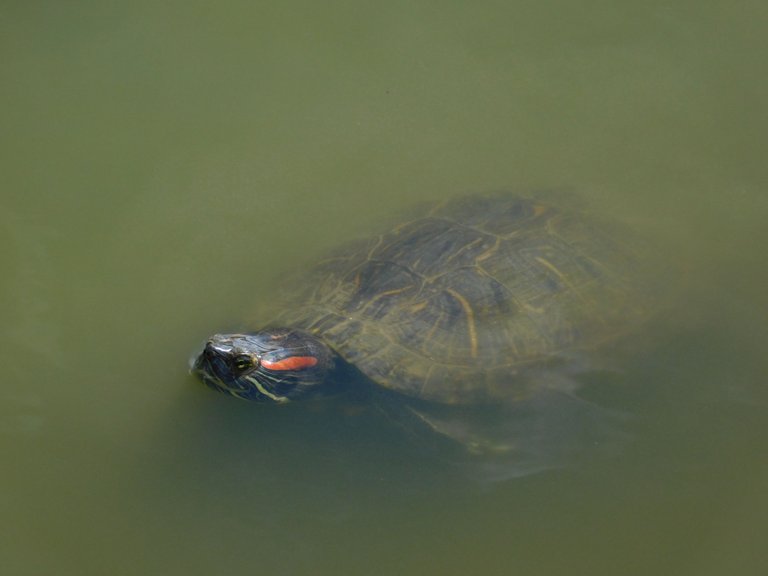
Image credit: agmoore
The red-eared slider is a solitary creature. It is born alone and lives alone. It finds a mate in spring, when the male inseminates the female. Courtship occurs under water, and the male can be quite aggressive. A female may be inseminated by more than one male. Therefore, the offspring from her clutch may have several fathers.
The eggs are not fertilized during mating, but during the egg laying process. The female holds onto the sperm until that time. Once the female has made her nest and deposited her eggs, her job is done. The young hatch in adult form (although of course they are smaller). They must survive on their own. Preparation for egg laying takes place close to water, but because the slider is an amniote, there has to be a terrestrial nest. Eggs are deposited in a shallow hole (which the turtle has excavated), within about 600 feet of the water.
Ambient temperature determines the gender (genotypic sex determination). Colder temperatures (71.6°-80.6 ° F) result in male offspring. Warmer temperatures yield female offspring.
Mallard Duck

Image credit: agmoore
According to the Royal Society for the Protection of Birds Mallards generally choose a nesting site near water. The nest will be covered by vegetation or, the ducks may find a hole in a tree in which to make a nest.
The ducks pair up in fall or winter, after the male courts with a mating display. The female chooses her mate. Male and female find an appropriate nesting site together. The male stays with the female until she lays her eggs. Then he abandons her to care for the eggs and ducklings on her own. After the eggs hatch the mother takes them to water almost immediately. They remain with their mother for fifty or sixty days, until they can fly.
The Pond
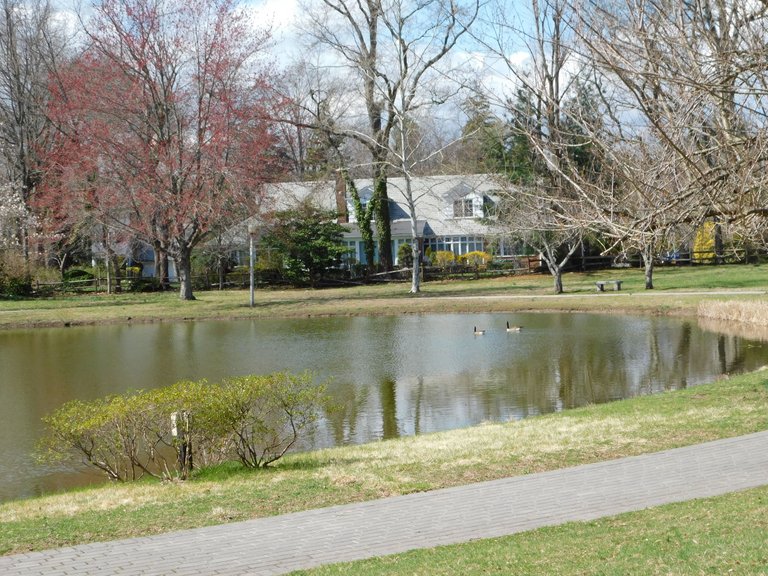
Image credit: agmoore
We know already, from the information above, how the pond helps the Mallard, the Canada goose, and the red-eared slider. It gives them a place to rest, to breed and to eat. Do the animals do anything for the pond? It seems they do.
The Canada Goose: According the Rutgers University Cooperative Extension, despite their reputation as bad neighbors, there are ecological advantages to having Canada geese around. Through all their prodigious poop, they spread seeds and help plants to grow in new areas. And, their poop actually is good for the soil (in moderation). It adds nutrients. Finally (and sadly) they are part of the food chain. Other animals, such as raccoons, foxes, snakes, and turtles feed off their eggs, and even the geese themselves.
Red-Eared Slider
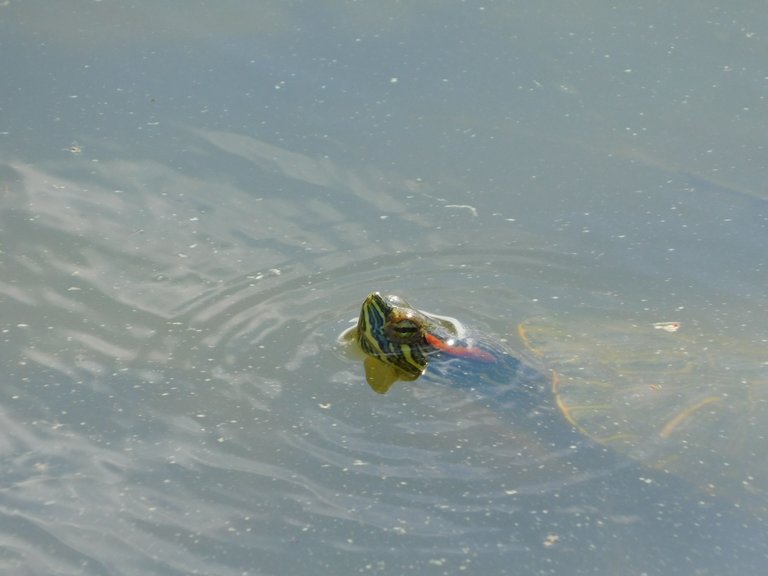
Image credit: agmoore
According to the website Magnolia Fisheries, red-eared-sliders are good for pond ecology. While some fishermen resent their presence because turtles eat fish, according to this website, any fish that is slow enough to be caught by a turtle is too sick for consumption. The turtle is doing us a favor by eating it. Because of their fondness for carrion and debris (sliders will eat anything) they help to keep the pond clean. The red-eared slider also helps to cut down on excess pond vegetation, and algae.
Mallard Duck
While ducks have sometimes been faulted for soiling areas with their poop, generally ducks are good for a pond. Drawing on information from the website, farmfromhome.com, I learned that ducks are often used as pond cleaners. If you have a snake problem, call in the ducks. If there is algae in your pond, call in the ducks. And, if there are too many frogs or insects, ducks will be very good friends to have around.
(Geese looking at me, as I'm looking at them)
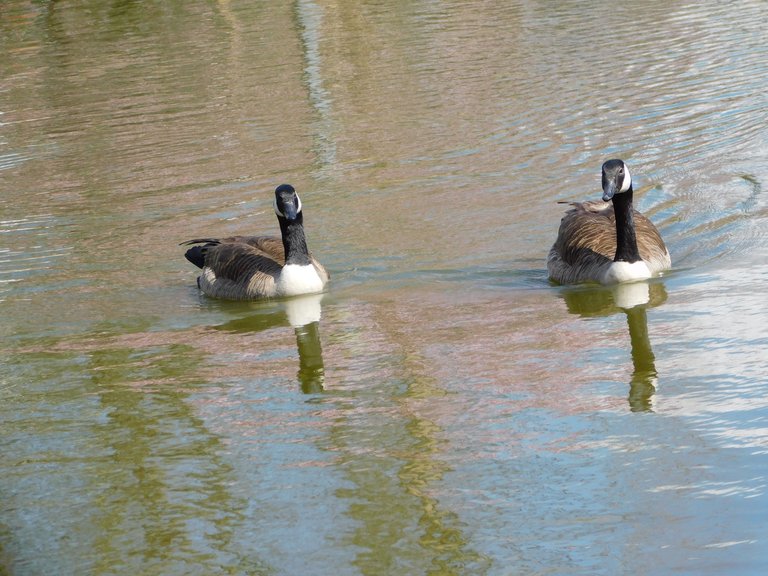
Image credit: agmoore
This blog was inspired by a peaceful walk on a lovely afternoon. The pond looked like a harmonious environment. I'm sure there was the drama of life and death going on under my nose. Isn't there always in nature? Winners and losers? But I won't let that thought ruin my impression of harmony. For one brief hour, on one sunny Sunday, the creatures of earth seemed to get along. Remarkably, none of them seemed to mind us, the humans.
Thank you for reading my blog. I hope you enjoyed the text and the pictures. All of these were taken with my camera, a little purple Nikon.

Turtle GIF: Turtle borrowed from the LMAC Image Library, LIL. Author: @muelli.
1https://www.beaumontenterprise.com/z-archived-entertainment/article/Red-eared-sliders-need-to-soak
2http://naturemappingfoundation.org/natmap/facts/red-eared_slider_712.html
3https://askanaturalist.com/who-is-eating-the-goslings/
4https://auduboninternational.org/wp-content/uploads/2019/03/WHM-Canada-Geese.pdf
5https://abcnews.go.com/Lifestyle/video/man-rescues-young-goose-turtle-attack-55665938
6
7https://www.dec.ny.gov/docs/administration_pdf/turtles2.pdf
8https://patch.com/new-york/kingspark/bp--all-about-long-island-turtles-natures-survivors
9https://www.pondboss.com/news/moderators-corner/to-aerate-or-not___is-it-really-a-question
10https://forgottenfriend.org/sliders/
11http://www.preservewildlife.com/canada-geese.html
12https://patch.com/new-york/kingspark/bp--turtles-dont-get-lost-people-do
13https://quoguewildliferefuge.org/news/creature-feature-eastern-box-turtle/
14https://www.turtleholic.com/midland-painted-turtle-profile/
15https://www.rspb.org.uk/birds-and-wildlife/wildlife-guides/bird-a-z/mallard/breeding/
16https://www.audubon.org/field-guide/bird/mallard
17https://www.turtlerescueofthehamptons.org/turtle-id/3296460
18https://www.allturtles.com/painted-turtle/
19https://fergusonmuseum.org/2014/06/nature-notes-fresh-water-turtles-of-fishers-island/
20http://www.turtlerescues.org/res.htm
21https://www.livescience.com/60054-animal-sex-red-eared-sliders.html
22https://www.geeserelief.com/geese-management/geese-breeding-season
23https://www.jsonline.com/story/communities/southwest/news/west-allis/2018/04/10/seven-things-you-never-knew-sex-lives/487046002/
24https://lakes.grace.edu/ponds-vs-lakes-whats-the-difference/
25https://esajournals.onlinelibrary.wiley.com/doi/full/10.1002/ecs2.3853
26https://www.dec.ny.gov/animals/34434.html
27https://www.nrcs.usda.gov/Internet/FSE_DOCUMENTS/nrcs141p2_018050.pdf
28https://farmfromhome.com/do-ducks-help-clean-ponds/
29https://creaseymahannaturepreserve.org/turtles-in-the-pond/
30https://magnoliafisheries.com/pond-turtles-good-or-bad/
31https://rangerplanet.com/do-mallard-ducks-mate-for-life-what-happens-and-timeline/
32https://www.biologyonline.com/articles/molecular-basis-of-temperature-dependent-gender-of-red-eared-slider-turtle
33https://www.encyclopedia.com/science/news-wires-white-papers-and-books/amniote-egg
34https://tpwd.texas.gov/huntwild/wild/species/slider/
35https://www.in.gov/dnr/fish-and-wildlife/hunting-and-trapping/canada-geese-management/behavior-and-biology/
36http://www.articles.lovecanadageese.com/lifemates.html
37https://www.easthamptonstar.com/archive/nature-notes-long-islands-ponds
38https://www.mentalfloss.com/article/76297/sort-bogus-reason-long-island-isnt-considered-island
39https://www.usgs.gov/centers/new-york-water-science-center/science/groundwater-sustainability-long-island-aquifer-system
40https://pubs.usgs.gov/wri/wri984069/pdf/wrir_98-4069_f.pdf)
41https://livestock.extension.wisc.edu/articles/the-origin-of-ducks/
42https://www.allaboutbirds.org/guide/Mallard/lifehistory
43http://nytts.org/nytts/NYS-ra-laws.htm
44https://www.wonderopolis.org/wonder/whats-the-difference-between-turtles-tortoises-and-terrapins
45https://petkeen.com/red-eared-slider-lifespan-how-long-do-they-live-captivity-wild/
46https://animals.net/painted-turtle/
47https://www.freep.com/story/news/local/michigan/2017/11/07/how-much-poop-can-one-canada-goose-poop-one-day-read/830375001/
48https://www.newyorkalmanack.com/2020/11/migrants-and-residents-canada-geese/
49https://www.dec.ny.gov/animals/7003.html
50https://www.dec.ny.gov/outdoor/28888.html
51https://www.humanesociety.org/sites/default/files/docs/canada-goose-guide.pdf
52https://www.sciencedirect.com/topics/engineering/anthropogenic-activity




